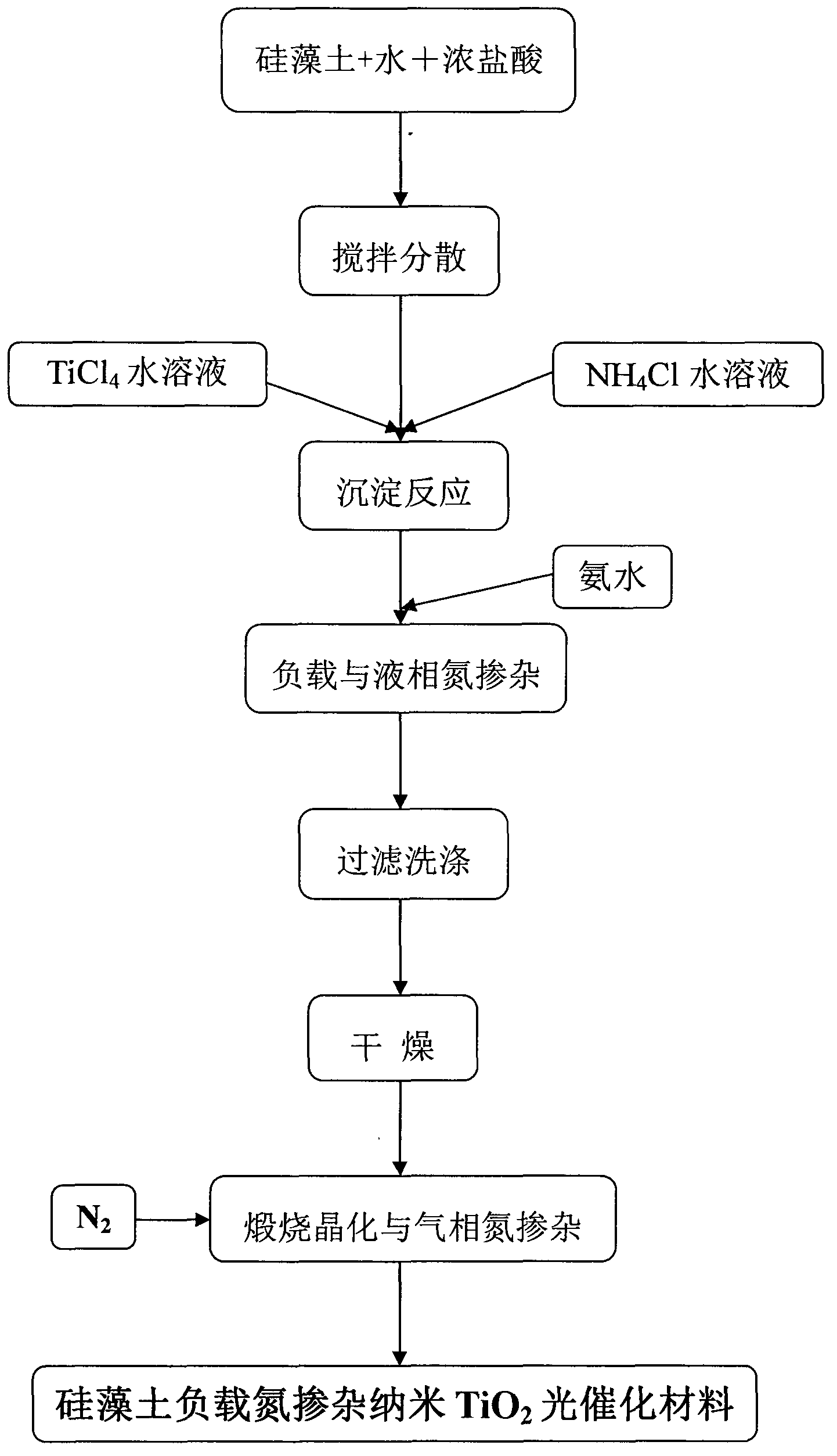Preparation method of diatomite-loaded nitrogen-doped nanometer TiO2 photocatalysis material
A technology of photocatalytic materials and diatomite, which is applied in chemical instruments and methods, physical/chemical process catalysts, chemical/physical processes, etc., can solve the problem of low utilization rate of natural light in photocatalysts, and achieve the effect of improving photocatalytic performance
- Summary
- Abstract
- Description
- Claims
- Application Information
AI Technical Summary
Problems solved by technology
Method used
Image
Examples
Embodiment 1
[0022] Take 100g of dry diatomite with a diatom content of 84.68% and 3000ml of deionized water to remove the 325-mesh sieve residue and add 100g of deionized water to the laboratory reactor to stir and make slurry, add hydrochloric acid to adjust the pH value of the slurry to 2; A good mass concentration is 200ml of 50% titanium tetrachloride aqueous solution and 150ml of ammonium chloride aqueous solution with a concentration of 200g / L; 30% concentrated ammonia and deionized water are made into an ammonia solution with a volume ratio of 1: 2.0 and added dropwise into the slurry at a rate of 2.4ml / min; stop the dropwise addition when the pH value of the system is 9.0; react at a temperature of 70°C for 2.0h and then filter and wash with water; the washed filter cake is dried at 105°C and beaten After dispersing, heat-preserve and calcinate at 600°C for 2 hours in a laboratory rotary tube furnace under the condition of nitrogen gas.
Embodiment 2
[0024] Take 100g of beneficiation diatom concentrate with a diatom content of 88.39%, add 3000ml of deionized water into a laboratory reactor and stir to make slurry, add hydrochloric acid to adjust the pH value of the slurry to 2; 200ml of titanium tetrachloride aqueous solution and 150ml of ammonium chloride aqueous solution with a concentration of 200g / L; 30% concentrated ammonia water and deionized water are made into an ammonia solution with a volume ratio of 1: 2.0 and added dropwise to the slurry at a rate of 2.4 ml / min; stop dropping when the pH value of the system is 9.0; react at a temperature of 70°C for 2.0h and then filter and wash with water; the washed filter cake is dried and dispersed at 105°C and then rotated in the laboratory Calcination at 600°C for 2 hours under the condition of nitrogen in the furnace.
Embodiment 3
[0026] Take 100g of calcined diatomite with a diatom content of 90.79%, add 3000ml of deionized water into a laboratory reactor and stir to make slurry, add hydrochloric acid to adjust the pH value of the slurry to 2; Titanium chloride aqueous solution 200ml and concentration are 150ml of ammonium chloride aqueous solution of 200g / L; 30% concentrated ammonia water and deionized water are made into the ammonia solution that volume ratio is 1: 2.0 and add dropwise in the slurry, the rate of addition is 2.4ml / min; stop dropping when the pH value of the system is 9.0; react at a temperature of 70°C for 2.0h and then filter and wash with water; the washed filter cake is dried at 105°C and dispersed in a laboratory rotary tube furnace Calcination at 600°C for 2 hours under the condition of medium nitrogen flow.
PUM
 Login to View More
Login to View More Abstract
Description
Claims
Application Information
 Login to View More
Login to View More - R&D
- Intellectual Property
- Life Sciences
- Materials
- Tech Scout
- Unparalleled Data Quality
- Higher Quality Content
- 60% Fewer Hallucinations
Browse by: Latest US Patents, China's latest patents, Technical Efficacy Thesaurus, Application Domain, Technology Topic, Popular Technical Reports.
© 2025 PatSnap. All rights reserved.Legal|Privacy policy|Modern Slavery Act Transparency Statement|Sitemap|About US| Contact US: help@patsnap.com


